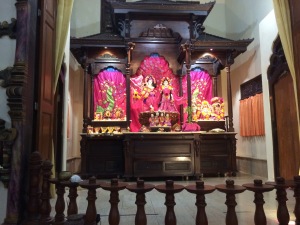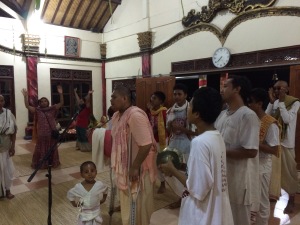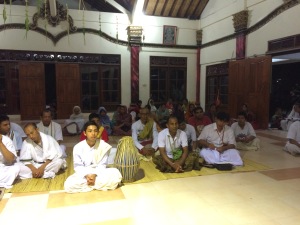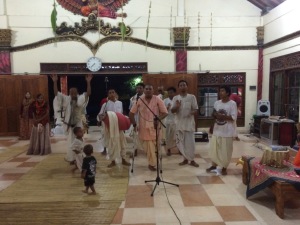Bhagavatam-daily 35 – 11.07.25 – Renunciation comes not from frustration but from illumination
HG Narottamananda Prabhu / BG 4.30 & Kirtan
→ Kalachandji's Audio Archive
HG Narottamananda Prabhu / SB 10.72.8-10
→ Kalachandji's Audio Archive
HG Narottamananda Prabhu / Kalachandji’s Bhagavad-Gītā Meditation Course – 38
→ Kalachandji's Audio Archive
Please Join The Japa Group
→ Japa Group
The Art of Devotion
In the artistic traditions of India, which…
→ Dandavats.com

The Art of Devotion
In the artistic traditions of India, which are rooted in its spiritual heritage, a devotee of Krishna finds inspiration for her spiritual practices. ” . I worship that transcendental seat, known as Svetadvipa … where every word is a song, every gait is a dance, and the flute is the favorite attendant.” . (Sri Brahma-samhita 5.56) What is the purpose of art? In art college I learned that it is a way to express something about oneself, something original. Fair comments, but what about the point of it all? What should be the reason for a work of art, a dance, or a piece of music? For many, it is the creation itself, or even the desire for the fame that comes with making something never created before.
http://goo.gl/A6hjVl
I Lost My Heart in Vrindavana!
The first time I entered the…
→ Dandavats.com

I Lost My Heart in Vrindavana!
The first time I entered the ISKCON temple in Mumbai – it was in February 2012 something caught my attention, besides, of course, the Deities and the beautiful architecture inside: I noticed many devotees wearing T-shirts carrying the slogan “I Lost My Heart in Vrindavana.” What’s so special about Vrindavana? I wondered. I had some faint idea about this place – how it was related to Lord Krishna’ s childhood activities – but nothing much.
After beginning to associate with devotees, I started to realize how this place is extremely special. Visiting such holy places, I learned, is an integral part of devotional service, and so devotees made regular pilgrimages to Vrindavana and meditated on its glories. Rupa Goswami, the sixteenth-century saint of medieval India, has described in his writings the exalted position of Vrindavana and the immense spiritual benefit one can derive by staying there. I hoped and prayed that I too would get an opportunity to go to Vrindavana.
http://goo.gl/y1hgJ9
Varnasrama series 2
→ SivaramaSwami.com
Why without being fixed in a bhakti-friendly social structure devotees will struggle to perfect themselves.
The post Varnasrama series 2 appeared first on SivaramaSwami.com.
Harinama in a wintery Moscow, Russia (Album 65 photos)
When the…
→ Dandavats.com

Harinama in a wintery Moscow, Russia (Album 65 photos)
When the Hare Krishna mantra is chanted by many men together, it is called sankirtana, and as a result of such a yajna there will be clouds in the sky (yajnad bhavati parjanyah [Bg.2.14]). In these days of drought, people can gain relief from scarcity of rain and food by the simple method of the Hare Krishna yajna. (Srimad-Bhagavatam, 9.1.17 Purport)
http://goo.gl/itrtWP
ISKCON Czech Republic – Indian festival in Pilsen, Czech…
→ Dandavats.com

ISKCON Czech Republic - Indian festival in Pilsen, Czech Republic
18 November 2014 (Album 26 photos)
Visit rate: 180 people. The special guest: HH Danavir Goswami
http://goo.gl/cCyXZU
New Vrindaban’s Transcendental Throwback Thursday – 11/20/2014
→ New Vrindaban Brijabasi Spirit
This week’s challenge: Many people will be enlivened to know the building in this photo is currently undergoing a major renaissance. Can you identify it, what purposes it’s served over the years, and possibly the era this photo was taken?
Extra credit: Can you ID any of the Matajis in the foreground?
What to do: Post your guesses on the “who, what, when, where & why” in the comment section at the Brijabasi Spirit website.
On a Thursday night
→ Krishna Lounge
What are the consequences of sin?
→ The Spiritual Scientist
Why is every sin ultimately a sin against God?
→ The Spiritual Scientist
What does it mean to be free from sin?
→ The Spiritual Scientist
What does it mean to be a slave to sin?
→ The Spiritual Scientist
How can I overcome a habitual sin?
→ The Spiritual Scientist
Ratha-yatra, November 16, Laguna Beach
Giriraj Swami
 “During the Ratha-yatra festival, Lord caitanya manifested the mood of Radharani wanting to bring Krishna back to Vrindavan. He would pull the chariot and that emotional process was pulling Krishna back to Vrindavan. In a way we want to install Krishna in our hearts. This body is compared to a chariot, so just as Lord Jagannatha was placed on a chariot at Ratha-yatra, we also want to place Lord Jagannatha or Krishna on the chariot of our hearts. But, in order to do that we have to cleanse our hearts.”
“During the Ratha-yatra festival, Lord caitanya manifested the mood of Radharani wanting to bring Krishna back to Vrindavan. He would pull the chariot and that emotional process was pulling Krishna back to Vrindavan. In a way we want to install Krishna in our hearts. This body is compared to a chariot, so just as Lord Jagannatha was placed on a chariot at Ratha-yatra, we also want to place Lord Jagannatha or Krishna on the chariot of our hearts. But, in order to do that we have to cleanse our hearts.”
True Authority, According to Śrī Jīva Gosvāmī
→ The Enquirer
This is a translation of Tattva-sandarbha 10 & 11, with “my” comments inset. Please think about the implications of excluding “Statements of Scholars” and “Tradition” from śabdha-pramāṇa and the significance this has on 95% of what is most often spoken on contemporary disscussions of śāstra (like Bhāgavatam classes or public lectures).
People have four flaws, beginning with misperception.
Therefore, our ability to ascertain the veracity of anything is limited, particularly in regard to things of a spiritual nature which are, by their very nature, beyond the boundaries of normal perception. For that we certainly require assistance from the uncommon words of the Veda.
1) Empirical perception (pratyakṣa)
2) Logical deduction (anumāna)
3) Expert instruction (śabda)
“Empirical perception” involves many forms of direct measurement (pratyakṣa) as well as indirect observation of the remote effect one entity exerts upon another (ceṣṭā).
“Logical deduction” involves many forms of extrapolation. Some examples are comparisons (upamāna), probabilities (arthāpatti), inferences (abhāva), and inclusions (sambhava).
“Expert instruction” means to receive valid information from someone who is an expert authority on a subject. However, this does not deserve to be a separate category unless the expert authority ascertains veracity on the basis of something other than empirical perception or logical deduction. For example, statements of scholars (ārṣa) seem like “expert instruction,” but it is relegated to Perception or Deduction if the scholars base their instruction primarily on their own empiricism or logic. Tradition (aitihya) is similar. Many people may accept an idea for a very long time, but this sort of authority is differentiated from “expert instruction” and relegated to the other two categories if the source of the tradition is someone’s perception or deduction.
If “expert instruction” does not originate from empirical observation or logical deduction, where does it originate? Śrī Jīva explains…
The beginningless and perfect words of the Veda are self-manifest and communicated to all people through paramparā.
“Logic and argument cannot prove or disprove transcendent things.”
— Vedānta Sūtra 2.1.11
“Argument is not capable of determining things that are beyond comprehension.”
— Mahābhārata Bhīṣma.5.22
“Such knowledge is born from Śāstra.”
— Vedānta Sūtra 1.1.3
“The Śruti is the ultimate root of the veracity of all concepts.”
— Vedānta Sūtra 2.1.27
“The Veda is the only eye through which anyone — human, ancestor, or god — can see the Supreme and come to understand the ultimate objective and means.”
— Śrīmad Bhāgavatam 11.20.4
Krsna’s Name Is Personal
→ Japa Group
A Day at Sri Mayapur International School
→ ISKCON News
Narendra Modi Calls for International Yoga Day
→ ISKCON News
ISKCON 50th Anniversary Gratitude Coin Announcement
→ ISKCON News

In order to celebrate the 50th anniversary of ISKCON, as well as to show our combined gratitude to its Founder/Acharya for this wonderful, transcendental gift he has given to us, the TOVP Fundraising Team has created a special Gratitude Coin Program for those who are able to offer a large amount of financial support.
Window Shopping
→ ISKCON News
Coal Rush in India Could Tip Balance on Climate Change
→ ISKCON News
New Album from Mandali
→ ISKCON News
Ekadasi at Radha Gopinath Mandir
→ Ramai Swami
On every Ekadasi, many devotees from Radha Gopinath Mandir, Bali, gather at the temple.
Bhagavatam-daily 34 – 11.07.24 – Learning from the past is a shortcut to learning
→ The Spiritual Scientist
Famous Indian Cricketer Parthiv Patel receives Bhagavad…
→ Dandavats.com

Famous Indian Cricketer Parthiv Patel receives Bhagavad Gita
Even a faint light from the holy name of the Lord can eradicate all the reactions of sinful life. (Sri Caitanya-caritamrta, Antya-lila, 3.63)
In remembrance of the disappearance of Sri Saranga Thakura, which is celebrated tomorrow
→ SivaramaSwami.com
The post In remembrance of the disappearance of Sri Saranga Thakura, which is celebrated tomorrow appeared first on SivaramaSwami.com.
Why do we sin?
→ The Spiritual Scientist
Are all sins equal to God?
→ The Spiritual Scientist
Do parents suffer the sins of their children?
→ The Spiritual Scientist
Are children punished for the sins of their parents?
→ The Spiritual Scientist
How can I know if something is a sin?
→ The Spiritual Scientist
What is the definition of sin?
→ The Spiritual Scientist
Is caffeine addiction a sin?
→ The Spiritual Scientist
Is it ever right to lie?
→ The Spiritual Scientist
Is joking a sin?
→ The Spiritual Scientist
Harinama(s) in Broadbeach and Surfers Paradise, 16 Nov…
→ Dandavats.com

Harinama(s) in Broadbeach and Surfers Paradise, 16 Nov 2014
Simply by chanting the holy name of Krishna, one can obtain freedom from material existence. Indeed, simply by chanting the Hare Krishna maha-mantra one will be able to see the lotus feet of the Lord. (Sri Caitanya-caritamrta, Adi-lila, 7.73)
http://goo.gl/LRHI00











